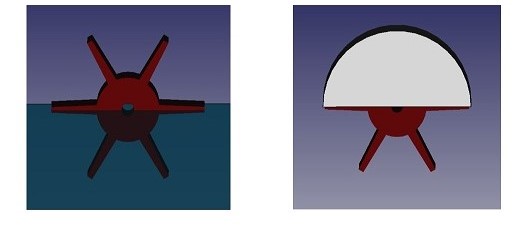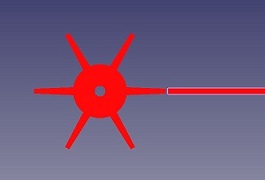Methode 1

Die von Raddampfern bekannten Schaufelräder tauchen nur teilweise in das Wasser ein. Nur der eingetauchte Teil des Schaufelrads
interagiert mit dem Wasser und erzeugt Schub.
Meine Versuche haben jedoch gezeigt, dass auch ein komplett getauchtes Schaufelrad Schub erzeugen kann, wenn es teilweise abgedeckt ist.
Das abgedeckte Teil des Schaufelrads interagiert nicht mit dem Wasser, als würde es nicht existieren (von etwas Reibung abgesehen).
Solch ein getauchtes und teilweise abgedecktes Schaufelrad funktioniert natürlich mit waagerechter und senkrechter Achse.
Diese Technik kann als Bug- oder Heckstrahlruder angewendet werden, oder auch als Antrieb.
Methode 2

Diese Methode ist nur sinnvoll bei vertikaler Achse. Das Schaufelrad ist nirgends abgedeckt, aber an einer Position des Umfangs
befindet sich ein 'Hindernis' (der Rumpf) und stoppt dort die Bewegung des Wassers.
Das bedeutet: Wenn das Schaufelrad rotiert, befördert es Wasser von einer Seite des Schiffs auf die andere, produziert so Schub.
Dazu muss das Schaufelrad nicht viele Schaufeln haben. Es funktioniert mit zwei Schaufeln ('RAKETE') oder nur einer Schaufel ('AAL').
Das Bugstrahlruder von 'MAX' ist eine Mixtur aus Methode 1 und 2. mit drei Schaufeln.
Das Drehmoment, das bei den Bugstrahlrudern mit senkrechter Achse entsteht, trägt auch noch zur Wirkung bei.
Schaufelrad- Bug- / Heckstrahlruder

ERIKA
MAX
MORITZ
RAKETE
AAL
Die einfachen Lösungen bei 'AAL' und 'RAKETE' mögen nicht perfekt Energie- effizient sein, sind aber leistungsfähig
und können in fast jede Schiffsform integriert werden.